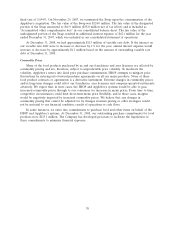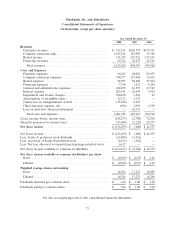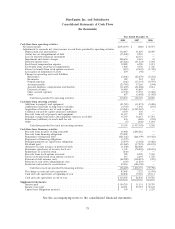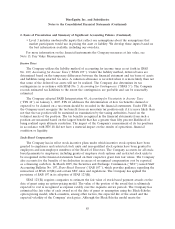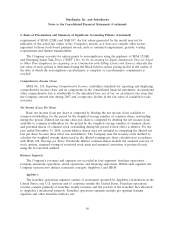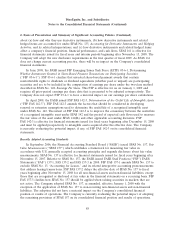IHOP 2008 Annual Report Download - page 94
Download and view the complete annual report
Please find page 94 of the 2008 IHOP annual report below. You can navigate through the pages in the report by either clicking on the pages listed below, or by using the keyword search tool below to find specific information within the annual report.DineEquity, Inc. and Subsidiaries
Notes to the Consolidated Financial Statements (Continued)
2. Basis of Presentation and Summary of Significant Accounting Policies (Continued)
Periodically, the Company will reacquire a previously franchised restaurant. At the time of
reacquisition, the franchise will be recorded at the lower of (1) the sum of the franchise receivables and
costs of reacquisition, or (2) the estimated net realizable value. The net realizable value of a reacquired
franchise is based on the Company’s average five-year historical franchise resale value. The historical
resale value used in 2008 was $200,000. An impairment loss will be recognized equal to the amount by
which the reacquisition value exceeds the historical resale value.
On a quarterly basis, the Company assesses whether events or changes in circumstances have
occurred that potentially indicate the carrying value of long-lived assets may not be recoverable. See
Note 7, Impairment and Closure Charges.
Goodwill and Intangible Assets
Goodwill is recorded when the aggregate purchase price of an acquisition exceeds the estimated
fair value of the net identified tangible and intangible assets acquired. Intangible assets resulting from
the acquisition are accounted for using the purchase method of accounting and are estimated by
management based on the fair value of the assets received. Identifiable intangible assets are comprised
primarily of trademarks, tradenames and franchise agreements. Identifiable assets with finite lives are
being amortized over the period of estimated benefit using the straight-line method and estimated
useful lives. Goodwill and indefinite life intangible assets are not subject to amortization.
In accordance with SFAS No. 142, Goodwill and Other Intangible Assets (‘‘SFAS 142’’), goodwill has
been allocated to three reporting units, the IHOP franchised restaurants unit (‘‘IHOP unit’’),
Applebee’s company-operated restaurants unit (‘‘Applebee’s company unit’’) and Applebee’s franchised
restaurants unit (‘‘Applebee’s franchise unit’’). The significant majority of the Company’s goodwill
resulted from the November 29, 2007 acquisition of Applebee’s and has been allocated between the
two Applebee’s units. The Company tests goodwill and other indefinite life intangible assets for
impairment on an annual basis in the fourth quarter. The impairment test of goodwill of the two
Applebee’s units was performed as of October 31, 2008. The impairment test of the goodwill of the
IHOP unit was performed as of December 31, 2008, the date as of which the analysis has been
performed in prior years. In addition to the annual test of impairment, goodwill must be evaluated
more frequently if the Company believes indicators of impairment exist. . Such indicators include, but
are not limited to, events or circumstances such as a significant adverse change in the business climate,
unanticipated competition, a loss of key personnel, adverse legal or regulatory developments, or a
significant decline in the market price of the Company’s common stock.
In the process of the Company’s annual impairment review, the Company primarily uses the
income approach method of valuation that includes the discounted cash flow method as well as other
generally accepted valuation methodologies to determine the fair value of our goodwill and intangible
assets. Significant assumptions used to determine fair value under the discounted cash flows model
include future trends in sales, operating expenses, overhead expenses, depreciation, capital
expenditures, and changes in working capital, along with an appropriate discount rate. Additional
assumptions are made as to proceeds to be received from future franchising of company-operated
restaurants. Step one of the impairment test compares the fair value of each of our reporting units to
their carrying value. If the fair value is in excess of the carrying value, no impairment exists. If the step
one test does indicate an impairment, step two must take place. Under step two, the fair value of the
assets and liabilities of the reporting unit are estimated as if the reporting unit were acquired in a
80


